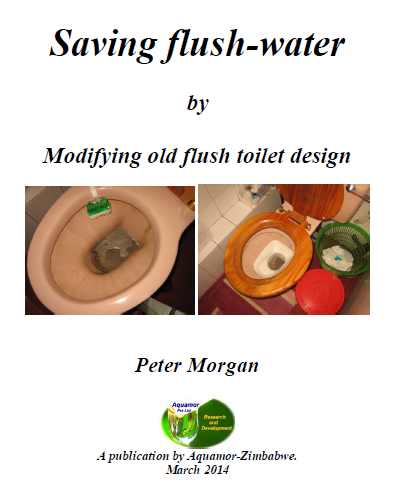- Forum
- categories
- Sanitation systems
- Toilets without urine diversion
- Low flush, pour flush, focus on flushing mechanism
- Simple flush toilet modification to use less water per flush
Simple flush toilet modification to use less water per flush
9989 views
Indeed water is wasted in huge amounts in many parts of the world. And yes the brick in the cistern works well, and I think is or has been used a lot in this part of the world. I have bent the brass bar on the ball valve, which I think achieves the same end result. One thing I learned from this very much "do it yourself" experiment, was how much the deposits had built up in the U bend, very much unnoticed from above. And very much interfering with smooth water flow. Even flush toilets require maintenance it seems. But what my family and I have also noticed is now much less water is required to make a good flush with the narrow opening at what I called the throat. I am not sure if this is the right word. Modern toilets seem to have narrower throats. We have family from UK here at the moment - a good test for the modification. The loo is used nonstop! No problems. it seems to work fine. As far as the modification of the activation of the cistern valve, that's pretty simple, but difficult to get a camera down there. so soon I will draw a sketch.
This is just an idea. to a few it may be of interest.
Just the work of a "back yard tinkerer!"
Best wishes
Peter
This is just an idea. to a few it may be of interest.
Just the work of a "back yard tinkerer!"
Best wishes
Peter
Peter Morgan
Harare, Zimbabwe
Website: www.aquamor.info
Harare, Zimbabwe
Website: www.aquamor.info
Please Log in to join the conversation.
You need to login to reply- PatrickBBB
-

- Water and environment engineer.
Less- Posts: 14
- Karma: 3
- Likes received: 7
Re: Simple flush toilet modification to use less water per flush
Very nice manual. All though the explanation of how to construct the flushing mechanisms should be more detailed.
As you reduce the area of the throat, does this increase the occurrences of the toilet being clogged? Its purpose is kind of defeated if you have to conduct additional flushing or worse, remove the blockage manually.
Kind regards
Patrick
As you reduce the area of the throat, does this increase the occurrences of the toilet being clogged? Its purpose is kind of defeated if you have to conduct additional flushing or worse, remove the blockage manually.
Kind regards
Patrick
I'm here to learn
Please Log in to join the conversation.
You need to login to replyRe: Simple flush toilet modification to use less water per flush
In the urban and peri-urban areas of Pakistan, the standard (old) flush toilets are used. The volume of the flush tank is nearly 11 liters. This is too much of a volume to be used per flush. During discussions on water conservation, I usually suggest placing the bricks (also referred to in the Peter’s document), in the flush tank, such that about 5 liters of the flush tank’s volume is occupied by the bricks. That would mean that only about 6 liters of water are used per flush.
This suggestion, to some extent, is acceptable to the people here, as the manufacturers here are in no mood to develop smaller-sized flush tanks. The main reason for this is the lack of sensitization towards water conservation. Water supply here is not metered, and the water rates are relatively low. Water (and it is not just water, it is treated drinking water) is, therefore, wasted to a large extent. To give an idea of water wastage, people wash their cars with hose pipe directly connected to a motor pump, which supplies water under pressure – wasting water to a large extent. On top of it, the water agency looks the other way, when told of water wastage.
F H Mughal
This suggestion, to some extent, is acceptable to the people here, as the manufacturers here are in no mood to develop smaller-sized flush tanks. The main reason for this is the lack of sensitization towards water conservation. Water supply here is not metered, and the water rates are relatively low. Water (and it is not just water, it is treated drinking water) is, therefore, wasted to a large extent. To give an idea of water wastage, people wash their cars with hose pipe directly connected to a motor pump, which supplies water under pressure – wasting water to a large extent. On top of it, the water agency looks the other way, when told of water wastage.
F H Mughal
F H Mughal (Mr.)
Karachi, Pakistan
Karachi, Pakistan
Please Log in to join the conversation.
You need to login to reply- Elisabeth
-
- User is blocked
- Freelance consultant since 2012
Less- Posts: 3372
- Karma: 54
- Likes received: 932
Re: Simple flush toilet modification to use less water per flush
Hi Juergen,
Maybe not everyone knows what an "AfriGadget" is?
www.afrigadget.com/
Greetings,
Elisabeth
Maybe not everyone knows what an "AfriGadget" is?
www.afrigadget.com/
Greetings,
Elisabeth
Dr. Elisabeth von Muench
Freelance consultant on environmental and climate projects
Freelance consultant on environmental and climate projects
The following user(s) like this post: jkeichholz
Please Log in to join the conversation.
You need to login to replyRe: Simple flush toilet modification to use less water per flush
Great modification, Peter! Looks like an AfriGadget to me 
Juergen Eichholz
watsan eng.
water, sanitation, IT & knowledge management
www.saniblog.org
Toilets in Frankfurt/Main www.facebook.com/ffmtoi
watsan eng.
water, sanitation, IT & knowledge management
www.saniblog.org
Toilets in Frankfurt/Main www.facebook.com/ffmtoi
Please Log in to join the conversation.
You need to login to reply
Dear Readers,
You may wish to read about a little bit of work I performed in our bathrooms recently.
We live in Harare, where piped water may be scarce. Our house is quite elderly and was fitted with flush toilets designed many years ago, when the full flush was quite an acceptable use of water. No longer so. In order to save on the amount of water used to flush the toilets (there are 2) I serviced and modified the toilets because they did not flush efficiently. First I found a build up of deposits (from the borehole water we use at the house) in the U bend, which disturbed the flow of water through the bend. This was dissolved off using diluted acid.
Second I modified the "throat" of the flush toilet where water passes into the U bend. Modern toilets have a much smaller cross sectional area at this point to increase water flow, when less water is used. Third, I modified the flushing arrangement, so the the user had control of the amount of water used. This is done automatically in many modern toilets with dual flush.
Experience with this work has already shown a considerable economy in the use of water, and I am pleased with the effort. The "do it yourself" type of person could do it easily. Perhaps there is also room for a mass produced plastic insert that could be place into an existing toilet to perform the same job. The simple fact is that we use far less water now for the flush than we did before. That's progress.
Best wishes
Peter
www.aquamor.info
Harare, Zimbabwe
You may wish to read about a little bit of work I performed in our bathrooms recently.
We live in Harare, where piped water may be scarce. Our house is quite elderly and was fitted with flush toilets designed many years ago, when the full flush was quite an acceptable use of water. No longer so. In order to save on the amount of water used to flush the toilets (there are 2) I serviced and modified the toilets because they did not flush efficiently. First I found a build up of deposits (from the borehole water we use at the house) in the U bend, which disturbed the flow of water through the bend. This was dissolved off using diluted acid.
Second I modified the "throat" of the flush toilet where water passes into the U bend. Modern toilets have a much smaller cross sectional area at this point to increase water flow, when less water is used. Third, I modified the flushing arrangement, so the the user had control of the amount of water used. This is done automatically in many modern toilets with dual flush.
Experience with this work has already shown a considerable economy in the use of water, and I am pleased with the effort. The "do it yourself" type of person could do it easily. Perhaps there is also room for a mass produced plastic insert that could be place into an existing toilet to perform the same job. The simple fact is that we use far less water now for the flush than we did before. That's progress.
Best wishes
Peter
www.aquamor.info
Harare, Zimbabwe
Peter Morgan
Harare, Zimbabwe
Website: www.aquamor.info
Harare, Zimbabwe
Website: www.aquamor.info
Attachments:
-
 Clipboard0...4-06.jpg
(Filesize: 16KB)
Clipboard0...4-06.jpg
(Filesize: 16KB)
The following user(s) like this post: jkeichholz
Please Log in to join the conversation.
You need to login to reply
Share this thread:
- Forum
- categories
- Sanitation systems
- Toilets without urine diversion
- Low flush, pour flush, focus on flushing mechanism
- Simple flush toilet modification to use less water per flush
Recently active users. Who else has been active?
Time to create page: 0.175 seconds









